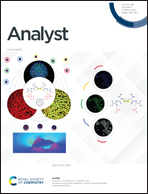Evaluation of covalent coupling strategies for immobilizing ligands on silica colloidal crystal films by optical interferometry
Abstract
Immobilizing ligands is a crucial part of preparing optical sensors and directly connected to the sensitivity, stability, and other characteristics of sensors. In this work, an ordered porous layer interferometry (OPLI) system that can monitor the covalent coupling process of ligands in real time was developed. Films of silica colloidal crystal (SCC), as optical interference substrates, were surface modified by three different reagents: chloroacetic acid, glutaric anhydride, and carboxymethyl dextran. Staphylococcus aureus protein A (SPA), the ligand, was immobilized on SCC films. The covalent coupling process of SPA and SCC films can be dynamically monitored by the OPLI system. In addition, the three different strategies were evaluated by comparing the efficiency of the sensors prepared by different methods for binding Immunoglobulin G (IgG). The glutaric anhydride-modified sensor offers apparent advantages in terms of bound IgG quantity and affinity. This system provides a simple and intuitive way to determine the efficiency of different covalent coupling strategies. Furthermore, the sensor covalently coupled with SPA also excels in the determination of IgG content in complex systems such as milk. At the same time, the covalent coupling gives the sensor the ability to be stored stably over time.

- This article is part of the themed collection: Analyst HOT Articles 2023


 Please wait while we load your content...
Please wait while we load your content...